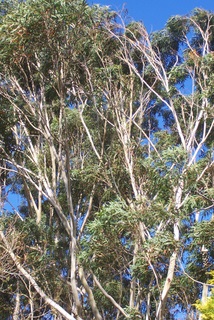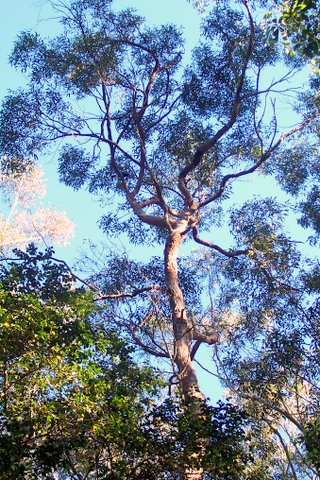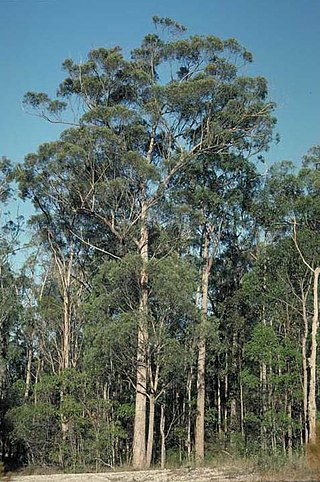
Eucalyptus caliginosa, commonly known as broad-leaved stringybark or New England stringybark, is a tree that is endemic to eastern Australia. It has stringy bark, lance-shaped or curved adult leaves, flower buds in groups of seven or nine, white flowers and more or less hemispherical fruit. It is common on the Northern Tablelands and North West Slopes of New South Wales and adjacent areas of Queensland.

Eucalyptus pilularis, commonly known as blackbutt, is a species of medium-sized to tall tree that is endemic to eastern Australia. It has rough, finely fibrous greyish bark on the lower half of the trunk, smooth white, grey or cream-coloured bark above, lance-shaped to curved adult leaves, flower buds in groups of between seven and fifteen, white flowers and hemispherical or shortened spherical fruit.

Eucalyptus notabilis, commonly known as Blue Mountains mahogany or mountain mahogany, is a species of small to medium-sized tree endemic to eastern Australia. It has rough, fibrous bark on the trunk and branches, lance-shaped to curved adult leaves, flower buds in groups of between seven and eleven, white flowers and hemispherical or conical fruit.

Eucalyptus acmenoides, commonly known as white mahogany or barayly, is a tree that is endemic to eastern Australia. It is a large tree with grey to reddish brown, stringy bark, lance-shaped leaves, oval to spindle-shaped buds and more or less hemispherical fruits. The two sides of adult leaves are very different shades of green.

Eucalyptus resinifera, commonly known as red mahogany or red messmate, is a species of medium-sized to tall tree endemic to coastal areas of eastern Australia. It has rough, stringy or fibrous bark on the trunk and branches, lance-shaped adult leaves, flower buds in groups of between seven and eleven, white flowers and hemispherical, conical or cup-shaped fruit.

Eucalyptus umbra, known as the broad-leaved white mahogany, is a species of small to medium-sized tree that is endemic to northern New South Wales. It has rough, fibrous to stringy bark on the trunk and branches, lance-shaped to curved adult leaves, flower buds in groups of seven to fifteen, white flowers and cup-shaped to hemispherical fruit.

Eucalyptus laevopinea, commonly known as the silver top stringybark, is a tree that is endemic to eastern Australia. It has rough, stringy greyish bark on the trunk and larger branches, glossy green, lance-shaped adult leaves, flower buds in groups of between seven and eleven, white flowers and hemispherical or shortened spherical fruit.

Eucalyptus tenella, commonly known as narrow-leaved stringybark, is a species of small to medium-sized tree that is endemic to New South Wales. It has stringy bark, narrow lance-shaped to linear leaves, flower buds in group of seven to fifteen, white flowers and hemispherical fruit.

Eucalyptus serraensis, commonly known as the Grampians stringybark, is a species of small tree or mallee that is endemic to the Grampians in Victoria, Australia. It has rough, stringy, fibrous or flaky bark on the trunk and sometimes also the branches, smooth bark above, lance-shaped to egg-shaped or round adult leaves, sessile flower buds in groups of three or seven, white flowers and hemispherical or cup-shaped fruit.

Eucalyptus apothalassica is a tree native to New South Wales in eastern Australia. Common names for the species include inland white mahogany.

Eucalyptus baileyana, commonly known as Bailey's stringybark, is a tree endemic to near-coastal areas of eastern Australia. It has rough, stringy bark on its trunk and main branches, lance-shaped adult leaves, flower buds in groups of seven, white flowers with stamens in four bundles and urn-shaped to more or less spherical fruit.

Eucalyptus psammitica, commonly known as bastard white mahogany, is a species of small to medium-sized tree that is endemic to eastern Australia. It has rough, stringy or fibrous, prickly bark on the trunk and branches, lance-shaped to curved adult leaves, flower buds in groups of between seven and eleven, white flowers and cup-shaped to hemispherical fruit.

Eucalyptus tetrodonta, commonly known as Darwin stringybark or messmate, is a species of medium-sized to tall tree that is endemic to northern Australia. It has rough, stringy or fibrous bark on the trunk and branches, lance-shaped leaves arranged in opposite pairs, flowers buds in groups of three, whitish to cream-coloured flowers and cylindrical fruit.

Eucalyptus carnea, known as the thick-leaved mahogany or broad-leaved white mahogany, is a species of tree that is endemic to coastal areas of eastern Australia. It has rough, stringy bark from the trunk to the thinnest branches, lance-shaped or curved adult leaves, flower buds in groups of between seven and eleven, white flowers and cup-shaped to hemispherical fruit.

Eucalyptus tenuipes, known as the narrow-leaved white mahogany, is a species of small tree that is endemic to Queensland. It has rough, fibrous bark, narrow lance-shaped leaves arranged in opposite pairs, flower buds in group of eleven to twenty, white flowers and spherical to hemispherical fruit.

Corymbia leichhardtii, commonly known as rustyjacket, Leichhardt's rustyjacket, or yellow jacket, is a species of tree that is endemic to Queensland. It has rough, tessellated bark on the trunk and branches, lance-shaped or curved adult leaves, flower buds in groups of seven, white flowers and barrel-shaped, urn-shaped or shortened spherical fruit.

Eucalyptus helidonica is a species of tree that is endemic to an area near Helidon in Queensland. It has rough, finely fibrous bark, lance-shaped or curved adult leaves that are paler on the lower surface, flower buds in groups of eleven or more, white flowers and shortened spherical or barrel-shaped fruit.
Eucalyptus imitans, commonly known as the Illawarra stringybark, is a species of small tree that is endemic to New South Wales. It has rough, stringy, greyish bark on the trunk and larger branches, lance-shaped, elliptic to egg-shaped or curved adult leaves, flower buds in groups of between nine and fifteen, white flowers and hemispherical fruit. It is found on near-coastal tablelands inland from the south coast.

Eucalyptus mediocris, commonly known as inland white mahogany, is a eucalypt that is endemic to the Australian state of Queensland.

Eucalyptus sphaerocarpa, commonly known as the Blackdown stringybark, is a species of tall forest tree that is endemic to Queensland. It has rough, stringy bark on the trunk and branches, lance-shaped to curved adult leaves, flower buds in groups of seven, nine or eleven, white flowers and shortened spherical fruit.


















